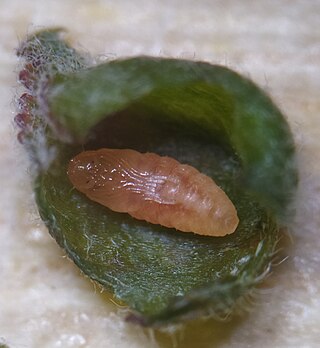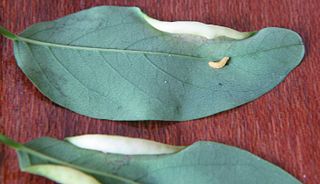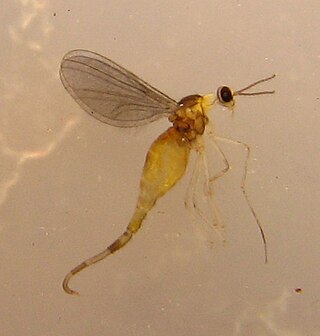Neolasioptera allioniae is a species of gall midges, insects in the family Cecidomyiidae. It forms galls in Allionia (Nyctaginaceae), possibly also other species in the family including Mirabilis nyctaginea. It occurs in the United States of America from Colorado to Texas, possibly more widely.

Asphondyliini is a tribe of gall midges in the family Cecidomyiidae. There are about six genera and at least 100 described species in Asphondyliini.

Rhopalomyia pedicellata is a species of gall midges, insects in the family Cecidomyiidae.

Rhopalomyia is a genus of gall midges, insects in the family Cecidomyiidae. There are at least 267 described species in Rhopalomyia. Most species in this genus induce galls on plants in the Asteraceae. This genus has a cosmopolitan distribution. Rhopalomyia was first established by Ewald Heinrich Rübsaamen in 1892.

Oligotrophini is a tribe of gall midges, insects in the family Cecidomyiidae. There are at least 20 genera and 300 described species in Oligotrophini.
Neolasioptera is a genus of gall midges, insects in the family Cecidomyiidae. There are at least 130 described species in Neolasioptera.
Alycaulini is a tribe of gall midges, insects in the family Cecidomyiidae. There are about 20 genera and at least 200 described species in Alycaulini.
Bremia is a genus of gall midges. There are at least 20 described species in Bremia.
Paradiplosis is a genus of gall midges, insects in the family Cecidomyiidae. There are at least four described species in Paradiplosis.
Thecodiplosis is a genus of gall midges, insects in the family Cecidomyiidae. There are about six described species in Thecodiplosis.
Craneiobia is a genus of gall midges in the family Cecidomyiidae. There are at least two described species in Craneiobia. They create tube-like galls on leaves of Cornus plants.
Pinyonia is a genus of gall midges, insects in the family Cecidomyiidae. There is at least one described species in Pinyonia, P. edulicola.
Micromyini is a tribe of wood midges, insects in the family Cecidomyiidae. There are about 9 genera and at least 30 described species in Micromyini.
Micromyinae is a subfamily of wood midges, insects in the family Cecidomyiidae. Its members were formerly included in subfamily Lestremiinae. There are at least 55 genera and more than 650 described species in Micromyinae. All species in this subfamily are mycophageous.

Dasineura gleditchiae, commonly known as the honeylocust podgall midge, is a species of gall midge in the family Cecidomyiidae. Native to North America, it is an invasive species in parts of Europe. The honeylocust podgall midge is a pest of honey locust, forming galls on the foliage.

Obolodiplosis is a genus of gall midges. It is monotypic, being represented by the single species Obolodiplosis robiniae, commonly known as the locust gall midge.

Winnertziinae is a subfamily of gall midges and wood midges in the family Cecidomyiidae.
Sackenomyia is a genus of gall midges, insects in the family Cecidomyiidae. There are about five described species in Sackenomyia.
Prodiplosis is a genus of gall midges, insects in the family Cecidomyiidae. There are about 11 described species in Prodiplosis.
Pilodiplosis is a genus of gall midges, insects in the family Cecidomyiidae. There is at least one described species in Pilodiplosis, P. helianthibulla.








